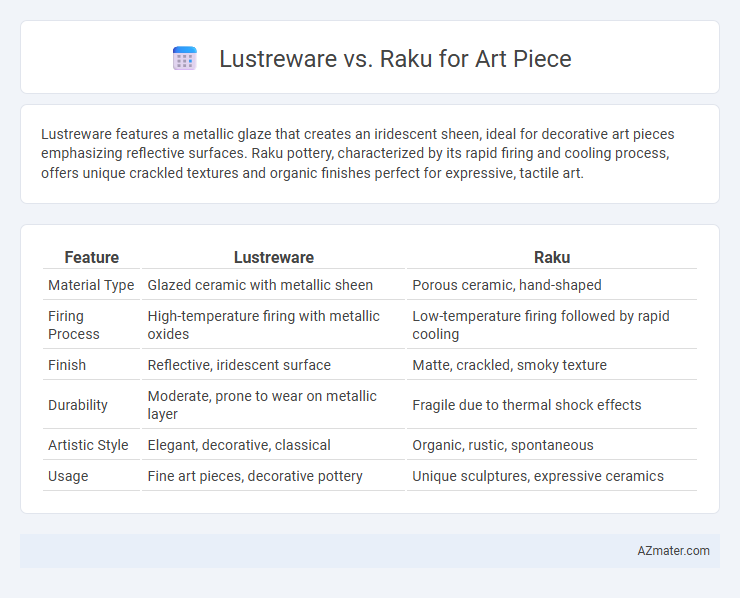Lustreware features a metallic glaze that creates an iridescent sheen, ideal for decorative art pieces emphasizing reflective surfaces. Raku pottery, characterized by its rapid firing and cooling process, offers unique crackled textures and organic finishes perfect for expressive, tactile art.
Table of Comparison
| Feature | Lustreware | Raku |
|---|---|---|
| Material Type | Glazed ceramic with metallic sheen | Porous ceramic, hand-shaped |
| Firing Process | High-temperature firing with metallic oxides | Low-temperature firing followed by rapid cooling |
| Finish | Reflective, iridescent surface | Matte, crackled, smoky texture |
| Durability | Moderate, prone to wear on metallic layer | Fragile due to thermal shock effects |
| Artistic Style | Elegant, decorative, classical | Organic, rustic, spontaneous |
| Usage | Fine art pieces, decorative pottery | Unique sculptures, expressive ceramics |
Introduction to Lustreware and Raku
Lustreware, characterized by its iridescent metallic glaze achieved through a complex luster firing process, dates back to ancient Mesopotamia and holds significant value in decorative art pieces. Raku is a Japanese pottery technique involving rapid removal from the kiln while red-hot, creating unpredictable cracks and smoky effects that emphasize spontaneity and natural beauty in ceramic art. Both Lustreware and Raku offer unique aesthetic qualities, with Lustreware prized for its shimmering surface and Raku celebrated for its organic textures and bold contrasts.
Historical Background of Lustreware
Lustreware, originating in the Middle East around the 9th century, is notable for its iridescent metallic glaze achieved through a complex firing process, making it a prized technique in ceramic art history. This method spread to Europe, notably in Spain and Italy during the Renaissance, influencing decorative art and elevating ceramic pieces into luxury art objects. Unlike Raku, which emerged in 16th century Japan with a focus on rapid firing and naturalistic aesthetics in tea ceremonies, lustreware emphasizes shimmering surface effects and historical craftsmanship rooted in ancient artisan traditions.
Origins and Evolution of Raku Pottery
Raku pottery, originating in 16th-century Japan, revolutionized ceramic art through its unique firing process that emphasizes rapid cooling and unpredictable glaze effects, contrasting with Lustreware's metallic glaze technique rooted in 9th-century Islamic art. The evolution of Raku pottery reflects a philosophy of spontaneity and wabi-sabi aesthetics, focusing on imperfection and natural beauty, whereas Lustreware's evolution highlights intricate craftsmanship and decorative refinement across Mediterranean cultures. Artists choosing between Lustreware and Raku often consider the historical significance and aesthetic outcomes influenced by their distinct cultural origins and technical practices.
Key Materials Used in Lustreware
Lustreware utilizes metallic oxides such as silver, copper, and gold to create its distinctive shimmering finish on ceramics, highlighting its rich reflective quality. These key materials interact with the glaze during a second firing in a reduction kiln, resulting in the iridescent surface that defines lustreware art pieces. In contrast, Raku focuses on rapid firing and cooling techniques, prioritizing the unique crackle and smoky effects over metallic luster.
Distinctive Glazing Techniques in Raku
Raku art pieces are renowned for their distinctive glazing techniques, which involve rapid cooling and reduction firing processes that create unique crackled textures and metallic lusters. Unlike Lustreware, which primarily features a delicate iridescent metallic glaze applied post-firing, Raku achieves a more organic, unpredictable finish through its direct interaction with fire and smoke. This unpredictability in Raku glazing results in one-of-a-kind surface patterns that are highly valued in contemporary ceramic art.
Color and Finish Comparisons
Lustreware offers a rich, metallic sheen characterized by its iridescent glaze that captures light and creates a shimmering surface, ideal for art pieces requiring a luminous, reflective finish. Raku ceramics, in contrast, feature more earthy tones with smoky, crackled textures resulting from rapid cooling techniques, imparting a raw, organic aesthetic to the artwork. The choice between Lustreware and Raku heavily influences the visual impact, with Lustreware emphasizing vibrant, polished color effects and Raku highlighting natural, matte finishes with unique surface variations.
Durability and Functional Aspects
Lustreware features a metallic glaze that enhances its aesthetic appeal while providing moderate durability, suitable for decorative art pieces but less ideal for heavy functional use. Raku pottery, fired at low temperatures and rapidly cooled, offers unique textures and colors but is more porous and fragile, making it less durable for everyday functional art. Both materials require careful handling, yet Lustreware is generally preferred for combining ornamental value with better surface resilience in art pieces.
Artistic Expression in Lustreware vs Raku
Lustreware offers a distinctive metallic sheen and vibrant iridescence that enhances artistic expression through its reflective and luminous surface, allowing artists to explore themes of light and dimension in their pieces. Raku, characterized by its unpredictable crackling and smoky textures, emphasizes organic imperfection and spontaneity, giving art pieces a raw, emotive quality. These contrasting techniques enable artists to convey vastly different moods and narratives, with Lustreware highlighting polished elegance and Raku embracing natural, elemental transformation.
Popular Contemporary Applications
Lustreware offers a shimmering, iridescent finish ideal for decorative art pieces that require a vintage or classical aesthetic, commonly used in ceramic wall art and collectible pottery. Raku firing techniques provide unpredictable crackle patterns and smoky textures, making them popular for contemporary sculptures and modern ceramic vessels that emphasize organic imperfection. Artists and collectors favor Raku for its ability to showcase dynamic surface effects, while Lustreware remains preferred for its elegant, lustrous sheen in contemporary decorative objects.
Choosing the Right Technique for Your Art Piece
Lustreware offers a unique iridescent finish achieved through metallic oxide glazes, ideal for artists seeking a glossy, reflective surface that enhances color depth and texture. Raku firing, known for its rapid cooling and crackled glaze effects, provides bold, unpredictable patterns perfect for expressive, organic art pieces. Selecting between Lustreware and Raku depends on the desired visual impact and firing process, with Lustreware emphasizing meticulous detail and Raku embracing spontaneous, textured aesthetics.

Infographic: Lustreware vs Raku for Art Piece
 azmater.com
azmater.com